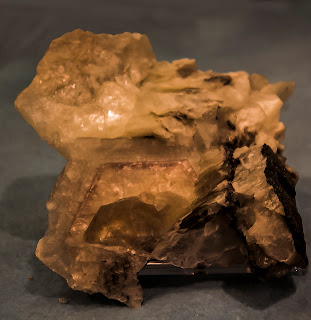George houses his collection in an addition to his and Karen's home. It consists of three rooms devoted to mineralogy. One enters into what he refers to as his "man cave," where he is shown sitting with his yellow Labrador Molly. Micromounting materials are evident on many surfaces. The walls bear an assortment of personal as well as mining memorabilia.
The "man cave" leads into a hallway with a mineralogy and mining history library with bookshelves on both sides. They extend from floor to ceiling with a ladder system. Multiple shelves have so many books on Colorado minerals and mineral localities that protruding sheets of card stock divide them according to counties within Colorado.
Beyond the library is the collection room. What first meets the eye is a relatively small single cabinet with minerals from the famous but now off-limits Hunting Hill Quarry in Montgomery County, Maryland. Otherwise, the cabinets are much larger. Keith Williams, who constructed numerous mineral cabinets at the Smithsonian, built most of them.
Specimens displayed in a long row of cabinets lining the left wall begin with a suite from the locality that's closest to where George lived most of his life, the fabled Centreville Quarry in Fairfax County, Virginia. Our title picture shows a few of the specimens. As everyone thereabouts who is interested in minerals knows, this locality has yielded too many world class apophyllite and prehnite specimens for passing judgment as to the best ever. What George's suite accomplishes is to show just how perfect they can get.
Specimens from Amelia County, Virginia are plentiful in an adjacent cabinet. It would be reasonable to conclude that some of the specimens in the image at left could vie for best of species from their specific Amelia County localities. Prominently displayed nearby are several relatively huge specimens with varied matrixes featuring turquoise crystals from the Bishop Copper Prospect in Lynch Station, Campbell County, Virginia.
Provenance is paramount. His labels name as many previous owners as he can ascertain. The ultimate Phoenixville Lead Mining District anglesite specimen from the Wheatley Mine is a good example. Collected between 1855 and 1860, it had eight previous owners going all the way back to the famous mining magnate and mineralogist Charles Wheatley. George also records this same information and other pertinent data about every specimen on index cards accompanied by all previous labels.
The collection boasts many scores of suites and individual specimens beyon the very small fraction of them mentioned herein. Standing out is a sizeable suite of gemmy minerals from Maine, a superb suite from Bisbee, Arizona, and a suite from Franklin and Sterling Hill, New Jersey width a specimen that amazed me of native gold in willemite .
George made a point of showing me a witherite specimen from the Pigeon Roost Mine near Glenwood in Montgomery County, Arkansas It is pictured at left. Clearly one of his favorites, he believes it could be a contender for the best of the species known to exist.
Nearby, a suite from Magnet Cove Arkansas, a favorite collecting spot for George, bears special mention. It includes a crystal of andradite (var.) melanite, which George thinks could be the best of its genre ever collected there.
Another garnet that impressed me nearly as much was prismatic and from North Carolina's Spruce Pine Mining District. Among numerous North Carolina minerals, he also pointed out a crystal of anatase pseudomorph after titanite from Tuxedo Junction at Zirconia in North Carolina's Henderson County.











No comments:
Post a Comment